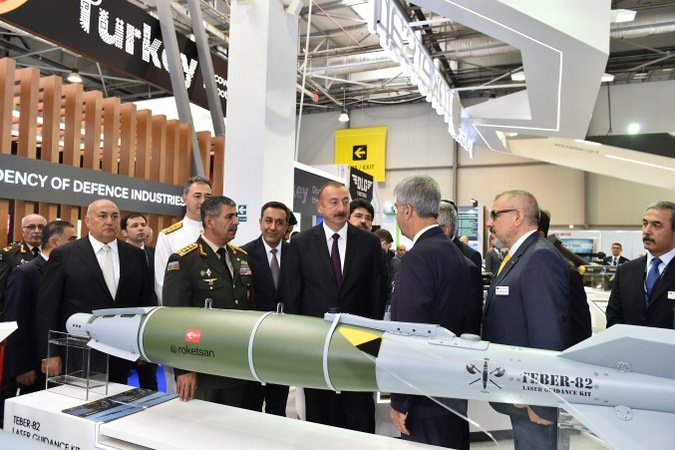
Since the 2000s, Azerbaijan has significantly improved its defense industry to the point where it now exports locally produced weapons to countries like Russia and the US. A large part of the country’s military development could be attributed to Israel.
Since regaining its independence in 1991, Azerbaijan set a target to increase the capability of its Armed Forces. Being a former Soviet country with an outdated industry, Azerbaijan has significantly developed and diversified its military industry since the end of the first Nagorno-Karabakh war. Throughout these years, Azerbaijan has done a lot to acquire international experience in the military industry.
At the beginning of the 2000s, official Baku adopted a new military policy, which would allow it to strengthen its military/defense industry. While oil-gas contracts brought billions of dollars and further foreign investments to Azerbaijan, the country’s military budget has implicitly increased between 2004 and 2012 years. As a part of this policy, in 2005, the Azerbaijani government established the Ministry of Defense Industry, which targeted to modernize the Soviet-era weaponry (mostly BMP, BRDM) in the balance of the Azerbaijani Armed Forces, and oversee arms manufacturing.
Although until 2013, the Azerbaijani defense industry has focused on purchasing different weaponry from Russia, Israel, Turkey, Pakistan, and Belarus, the country has been building up its own capabilities to produce new weaponry. According to the statistics of the Ministry of Defense Industry, Azerbaijan today offers 1100 different kind of domestically produced weaponry, including vehicles, rifles, mines, and other military equipment.
Last year, Azerbaijan displayed newly produced weaponry at ADEX-2016 (Azerbaijan Defense Exhibition). Among the country’s newly-made weapons were the ‘Shimshek-10’ machine gun, equipped with a day/night cameras, and designed mainly to be installed on tanks and armored personnel carriers; the ‘Gurza’ armored vehicle for Special Forces; the ‘BRDM-2’ equipped with a Turkish-made anti-tank missile complex; the ‘Istiglal-1T’ anti-materiel rifle; the ‘Yalguzag‘ and ‘Mubariz’ sniper rifles, which are considered the most popular weaponry of the local industry, according to mass media. “The Azerbaijani-made weaponry meets the standards of NATO,” said Minister of Defense Industry Yavar Jamalov in his speech at ADEX-2016. Additionally, Minister Jamalov publicly underlined the fact that Azerbaijan currently exports its domestically made RPQ-7V2 Gaya grenade-launcher, EM-14 automatic rifle, and optic sights to ten foreign countries, including the US, Russia, Pakistan, Iraq (imported 500 RPQ-7V2 in 2016), and several Gulf monarchies.
It seems that the Azerbaijani defense industry is eager to improve its indigenous production capability even more by 2020. In December of 2016, during an interview with local journalists, Minister Yavar Jamalov said that the Ministry of Defense Industry works on producing a long-range missile system and an electromagnetic weapon that will be capable of destroying enemy military equipment.
Apparently, the Azerbaijani Armed Forces have had a chance to use domestically made weaponry on the battlefield, against Armenia-backed separatist forces in the Nagorno-Karabakh region. In April 2016, the region has witnessed an unexpected war between Azerbaijan and Armenia in the Nagorno-Karabakh region. But unlike other clashes in the frontline between Azerbaijan and Armenia, April’s clashes featured the first known use of “kamikaze drones” by Azerbaijan, with the explosive-tipped aircraft. In March, Azerbaijan signed a $1.6 billion arms deal with Israel, which consisted largely of advanced drones (Hermes-450 and Aerostar) and an air defense system. Through this and other deals, Azerbaijan is currently amassing a squadron of over 100 drones from all three of Israel’s top defense manufacturers.
The effectiveness of the so-called “Drone wars” had pushed official Baku to purchase more Israeli-made drones. Simultaneously, Azerbaijani officials said that the country would build “hundreds” of kamikaze and other combat drones using Israeli technology. Speaking on Saturday while visiting Azeri troops stationed southeast of Nagorno-Karabakh at one of the hills recaptured in April, President Ilham Aliyev said his country has already purchased modern weapons worth billions and intends to produce its own drones.
In October, Azerbaijan has demonstrated its first domestically produced drone ‘Zerbe’ (Strike) at the ADEX-2016 fair. Few of its specifications have been made public, but it appears similar to the Israeli Orbiter 1K, with an armed warhead, stealthy profile, and an endurance of up to three hours. Azerbaijan’s Ministry of Defense has ordered more than 100 Zerbe drones, which “have become a nightmare for the Armenian army,” Jamalov said.
Obviously, one of Azerbaijan’s main reasons for mass-producing kamikaze drones and other military equipment is the appearance of the ‘Iskander-M’ missile system in the balance of Armenian Armed Forces. Some Armenian experts argue that the missile system will largely shift the balance of power in favor of Armenia. However, the Azerbaijani Defense Ministry assured that the country has quite capable and powerful weapons to counter Armenia’s Iskander rockets. Nevertheless, the acquisition of the Iskander-M missile system by Yerevan will not ease tensions in the region. On the contrary, it will largely contribute to the escalation of conflict in the Nagorno-Karabakh region, and to the arms race between Azerbaijan and Armenia.
Published by Israel Defense Magazine
Fuad Shahbazov is a Research Fellow for the Foreign Policy Analysis Department at the Center for Strategic Studies in Azerbaijan.
